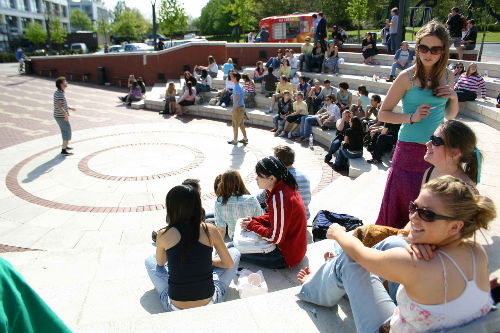
June 24, 2008, by Peter Kirwan
The Tempest (Warwick Students’ Art Festival) @ University of Warwick Piazza
This pared-down version of The Tempest was the first of two Shakespeare production in the 2008 Warwick Student Arts Festival. Its novel setting, in the mock classical amphitheatre of the University of Warwick’s Piazza, combined with a sunny Monday afternoon to create a festive atmosphere for what was essentially an exhibition piece, Shakespeare for Shakespeare’s sake. Rather than providing a detailed interpretation, thematic exploration or innovative textual reading (which would have been difficult, given the production’s hour-and-a-half slot), director Simon Ferdinand presented a version retaining less than a third of the text that collated highlights of the play and married them to visual and aural images, wisely making it simple and accessible for the casual audience eating ice-cream on the piazza steps. It took place in the central floor space, with a simple set consisting of a couple of upturned log stumps.
Source: University of Warwick website
One of the primary pleasures of this production was the music, directed by Tanya Wells. The eight musicians sat in a semi-circle behind the actors, playing djembe-style drums and singing to accompany the action. The sophistication of the harmonies was surprising, considering that the performance was a one-off, and there were some lovely moments such as the wedding of Miranda and Ferdinand that showcased their talents, walking among the actors and creating a blanket of sound that was simply lovely. Melodies were created to accompany most of the primary characters, drumming for the tempest itself and a conch was periodically blown at formal points of procession.
The main innovation of the production was the casting of four girls as Ariel, dressed and made up in four distinct colour schemes to represent the four elements. This allowed the Ariels to create many of the effects as a group – waving a sheet up and down for the stormy sea, escorting the nobles off in different directions, moving around the stage behind Trinculo to whisper things and, in one excellent moment, walking around Prospero as he abjured his rough magic with old books, tearing out pages and dropping them to the floor until the piazza became full of torn pages blowing in the wind at the actors’ feet. Playing up to the elemental nature of Ariel also made for nice moments such as the "Fire" Ariel speaking the line "The fire and cracks of sulphurous roaring" with a smile and nod to her own colouring, and of course Prospero’s release of the quartet to the elements.
Prospero himself, played by Paul Edkins, looked uncannily like Jesus with beard, long hair, white toga and long staff. His performance was formal and upright, the actor using his height to full advantage. This Prospero stood aloof from the rest of the activity, supremely confident in his strength and of the outcomes, and cutting reduced his part primarily to well-spoken orations. The other nobles also wore togas and sandals, but had almost nothing to do. Sebastian was entirely cut, as was the conspiracy subplot. After the tempest they were led off blindfolded and were not seen again until almost the end of the play where their scenes were conflated into one, with only a snippet of Gonzalo’s utopia speech and part of Alonso’s mourning left in. More space was given to Ferdinand and Miranda’s romance, which was played largely straight.
In the same way, Trinculo and Stephano were reduced to a single scene. Zoe ‘Bob’ Roberts gave a commendable bit of energy as the drunken Stephano, retching into audience members’ laps and indulging in fantasies of ruling with comic blokishness. Lydia Rynne, meanwhile, in dirty brown smock and muddy face, was a despairing and beaten Caliban who railed against Prospero bitterly while remaining largely sympathetic. With the clowns, she became a staggering drunk, yet there was still sadness as she chanted her name. In a shock move, though, the next we heard of the conspiracy was when the Ariels entered with bloody bags with their heads in, one throwing Caliban’s down from the top of the piazza steps to land at Prospero’s feet. It was an effective moment, though entirely out of keeping with what had come before, showing Prospero to be shockingly harsh when everywhere else he was apparently benign. Prospero’s next line, "Now does my project gather to a head", suggested that this decision may have been taken in order to effect a particularly bad pun.
At just over an hour long, this production was in essence, and in the best possible sense, pointless, a pleasant way to pass a fraction of an afternoon without being challenged or required to do much thinking. However, it wasn’t a production to be casually dismissed, being considerably better developed than one would have expected such an abbreviated piece to be. Many of the images were striking, and combined with the music there was much to take away from the performance, and it would be lovely to see this developed into a full production.
No comments yet, fill out a comment to be the first

Leave a Reply